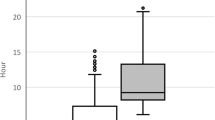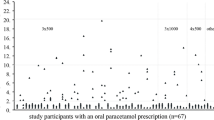Abstract
Purpose
To evaluate reported ingested dose of paracetamol as a risk assessment tool in acute paracetamol overdose.
Methods
Data was retrospectively obtained from a clinical toxicology database linked to one Australian and two United Kingdom hospitals. Plasma paracetamol concentrations (PPCs) of adult patients presenting with acute single ingestion, non-staggered paracetamol deliberate self-poisoning between 2006 and 2012 were recorded and plotted on a treatment nomogram to determine accuracy of reported dose ingested as an indicator for antidotal treatment. PPC plotted on a treatment nomogram with a line intersecting a 4-h concentration of 100 mg/L [667 μmol/L] was considered an indication for antidotal treatment in the UK; the corresponding Australasian population utilised a line intersecting 150 mg/L [1000 μmol/L].
Results
Of 1246 patients, 65.7 % were female and 88 % were from the UK. Fifty-two percent of patients reporting ingestion of ≥8 g paracetamol had a PPC above the 100 mg/L treatment line; PPV 52 % [95 % confidence interval (CI) 49 %, 55 %], sensitivity 81 % [95 %CI 78 %, 85 %]. Forty-four of patients reporting percent ingestion of ≥10 g had a PPC above the 150 mg/L treatment line; PPV 44 % [95 % CI 41 %, 49 %], sensitivity 85 % [95 % CI 78 %, 89 %], 72 % of patients reporting ingestion of ≥16 g had a PPC above the 100 mg/L treatment line; PPV 72 % [95% CI 67 %, 77 %], sensitivity 50 % [95 % CI 45 %, 54 %]. Overall, there was moderate correlation (R = 0.58) between reported paracetamol dose ingested and extrapolated 4-h PPC.
Conclusions
There is a positive correlation between reported ingested dose of paracetamol and subsequent chance of a PPC being above a defined treatment line; however, ingested dose of paracetamol alone is a poor risk assessment tool in accurately determining need for treatment with an antidote.


Similar content being viewed by others
References
Bronstein AC, Spyker DA, Cantilena LR Jr, Green JL, Rumack BH, Giffin SL (2010) Annual report of the American Association of Poison Control Centres’ national poison data system (NPDS):27th annual report. Clin Toxicol 48:979–1178
Khan LR, Oniscu GC, Powell JJ (2010) Long-term outcome following liver transplantation for paracetamol overdose. Transpl Int 23:524–529
Larrson AM, Polson J, Fontana RJ, Davern TJ, Lalani E, Hynan LS et al (2005) Paracetamol-induced acute liver failure: results of a United States multicenter, prospective study. Hepatology 42:1364–1372
Daly FFS, Fountain JS, Murray L, Graudins A, Buckley NA (2008) Guidelines on the management of paracetamol poisoning in Australia and New Zealand. Med J Aust 188:296–301
Ferner RE, Dear JW, Bateman DM (2011) Management of paracetamol poisoning. BMJ 342:2218
Shihana F, Dissanayake DM, Dargan PI, Dawson AH (2010) A modified Low cost colourimetric method for paracetamol (acetaminophen) measurement in plasma. Clin Toxicol 48:42–46
Senarathna SMDKG, Ranganathan SS, Dawson AH, Buckley N, Fernandopulle BMR (2008) Management of acute paracetamol poisoning in a tertiary care hospital. Ceylon Med J 53:89–92
Thomas SH, Horner JE, Chew K, Connolly J, Dorani B, Bevan L et al (1997) Paracetamol poisoning in the north east of England: presentation, early management and outcome. Hum Exp Toxicol 16:495–500
Waring WS, Robinson OD, Stephen F, Dow MA, Pettie JM (2008) Does the patient history predict hepatotoxicity after acute paracetamol overdose? QJM 101:121–125
Zyoud SH, Awang R, Sulaiman SA (2012) Reliability of the reported ingested dose of paracetamol for predicting the risk of toxicity in paracetamol overdose patients. Pharmacoepidemiol Drug Saf 21:207–213
Duffull SB, Isbister GK (2013) Predicting the requirement for N-acetylcysteine in paracetamol poisoning from ingested dose. Clin Toxicol (Phila) 51(8):772–776
Ganga Senarathna SMDK, Ranganathan SS, Buckley N, Soysa SS, Fernandopulle BM (2012) A quick inexpensive laboratory method in acute paracetamol poisoning could improve risk assessment, management and resource utilisation. Indian J Pharmacol 44:463–468
Prescott LF, Roscoe P, Wright N, Brown SS (1971) Plasma-Paracetamol half-life and hepatic necrosis in patients with paracetamol overdosage. Lancet 1:519–522
Paudyal BP (2005) Poisoning: pattern and profile of admitted cases in a hospital in Central Nepal. J Nepal Med Assoc 44:92–96
Dawson AH, Henry DA, McEwen J (1989) Adverse reactions to N-acetylcysteine during treatment for paracetamol poisoning. Med J Aust 150:329–331
Schmit LE, Dalhoff K (2001) Risk factors in the development of adverse reactions to N-acetylcysteine in patients with paracetamol poisoning. Br J Clin Pharm 51:87–91
Yip L, Dart RC, Hurlbut KM (1998) Intravenous administration of oral N-acetylcysteine. Crit Care Med 26:40–43
Waring WS, Stephen AF, Robinson OD, Dow MA, Pettie JM (2008) Lower Incidence of anaphylactoid reactions to N-acetylcysteine in patients with high paracetamol concentrations after overdose. Clin Toxicol 46:496–500
Hendrickson RG, McKeown NJ, West PL, Burke CR (2010) Bactrian (“double hump”) paracetamol pharmacokinetics: a case series and review of the literature. J Med Toxicol 6:337–344
Adams BK, Mann MD, Aboo A, Isaacs S, Evans A (2004) Prolonged gastric emptying half-time and gastric hypomotility after drug overdose. Am J Emerg Med 22:548–554
Reddick AD, Kirsten H, Morrison WG (2010) Effect of concomitant opiate ingestion on paracetamol levels in acute overdose. Emerg Med J 27:742–744
Wang GS, Monte A, Bagdure D, Heard K (2011) Hepatic failure despite early acetylcysteine following large paracetamol-diphenhydramine overdose. Paediatrics 127:1077–1080
Conflict of interest
This study is not funded. PID and DMW have previously received funding from McNeil Pharmaceuticals for a study to undertake a population survey of home stores of paracetamol in the UK. PID has been an expert adviser to the FDA on paracetamol poisoning. The other authors report no conflicts of interest.
Authors’ contributions
YL, DT, PD, DW and SG designed the study. YL and SG extracted study data. YL, DT, PD, DW and SG interpreted the study data, YL wrote the first draft of the paper. YL, DT, PD, DW and SG reviewed and finalised the final manuscript.
Author information
Authors and Affiliations
Corresponding author
Rights and permissions
About this article
Cite this article
Leang, Y., Taylor, D.M., Dargan, P.I. et al. Reported ingested dose of paracetamol as a predictor of risk following paracetamol overdose. Eur J Clin Pharmacol 70, 1513–1518 (2014). https://doi.org/10.1007/s00228-014-1756-0
Received:
Accepted:
Published:
Issue Date:
DOI: https://doi.org/10.1007/s00228-014-1756-0




